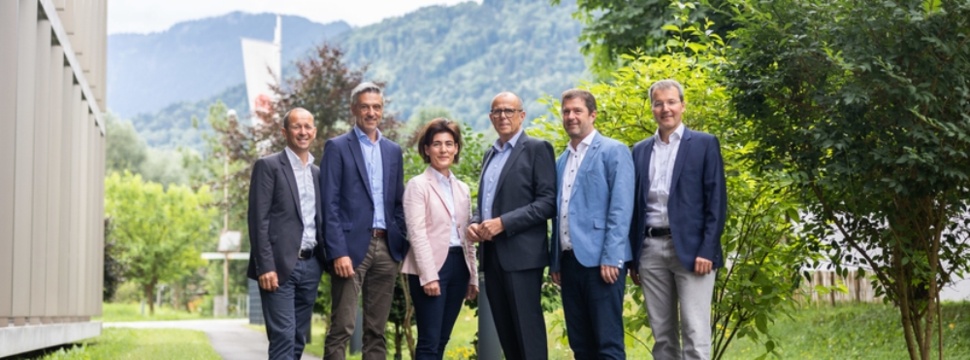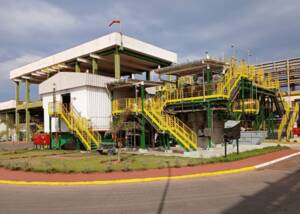New waste material power plant for “Energy Autonomy Frastanz"
News General news
Expansion of the local heating network with energy generation in Vorarlberg

As part of the “Energy Autonomy Frastanz” (“Energieautonomie Frastanz”) initiative, the construction of a new waste material power plant is planned on the premises of Rondo Ganahl AG. This will satisfy both the thermal energy requirements of the paper and corrugated board factory and feed energy into the local district heating network. In addition, the expansion of the existing local heating network fills a shortfall in the southern district. In the future, other businesses such as the Frastanz brewery will also be supplied and up to 500 private households may be connected. Construction of the power plant means “Energy Autonomy Frastanz” is taking a clear, important step towards independence from fossil fuels.
“It is high time that we put our energy supply on a new footing and took responsibility for our employees and customers,” says Hubert Marte in response to the gas supply uncertainty – for example, just last week the German government declared the second crisis stage in the gas emergency plan. That’s why the “Energy Autonomy Frastanz” project is starting to make headway and, with the construction of its own power plant, valuable leftover materials in Vorarlberg are being turned into precious valuable energy sources. In addition, opportunities also exist to expand the local “Biowärme Frastanz” heating network in the town. “Energy Autonomy Frastanz” is a joint initiative of the paper and corrugated board specialist Rondo, the municipality of Frastanz, E-Werke Frastanz and the Frastanz brewery. “It’s crucial that we no longer heat with oil and gas, which is why we want to offer both private households and business a sensible alternative,” explains Walter Gohm, mayor of the market town of Frastanz.
Energy for paper production
Among several options available, this is being achieved by constructing a waste material power plant on the Rondo premises. The planned power plant will be used, in particular, to allow the company to generate the process heat required for its paper and corrugated board factory self-sufficiently in the future, as the production of base paper is very energy-intensive. Until now, the necessary thermal energy could only be generated with gas at the Frastanz site – and made Rondo Vorarlberg's largest natural gas buyer. Around 14 million standard cubic metres of gas or 150 GWh of thermal energy are currently required annually, which corresponds to the annual demand of around 10,000 households. “For us, the new waste material power plant is a major and necessary step out of fossil natural gas,” says Hubert Marte, CEO of Rondo Ganahl AG, optimistically and explains: “We have a great opportunity here to take control of our own energy supply and become independent of apparently uncontrollable, foreign suppliers. With an estimated 70 million euros, this is also a major investment for us. But in the long term, this power plant strengthens our location as the company headquarters, so this goes towards securing the jobs of around 400 employees on-site.”
Supply of brewery and businesses
In addition to the paper mill, other companies will also be able to receive thermal energy from the power plant. First and foremost, the Frastanz brewery as an immediate neighbour and also a partner of “Energy Autonomy Frastanz”, which will be able to cover its current demand of 5 GWh per year. “We also have energy-intensive processes in beer brewing. We therefore welcome the expansion of the grid and the self-generated supply of thermal energy in order to get a better grip on the almost incalculable and sharply rising energy prices at present,” says Kurt Michelini, Managing Director of the Frastanz brewery.
Achieving climate targets
Up to 500 private households could also benefit if the power plant is integrated into the Frastanz local heating network. Rainer Hartmann, Managing Partner of E-Werke Frastanz GmbH, explains: “As the owner and operator of Biowärme Frastanz including the local heating network, our goal is to continuously improve our services and connect as many other properties and households as possible. This is exactly what we could do with the ‘Energy Autonomy Frastanz’ project. This allows us to make an important contribution to climate protection in our town.” The new waste material power plant represents a great opportunity to connect the municipality’s southern district, which is not yet part of the Biowärme Frastanz network. The existing biomass heating plant already supplies almost 80 customers – including the municipality, the parish, companies and numerous private households. The new power plant means that the reliability of the entire system can be increased, and capacity utilisation optimized. Through this expansion, Frastanz is also taking an important step towards the climate targets set by the EU, which aim to reduce greenhouse gas emissions by at least 55% by 2030 – called “Fit for 55”.
Modern power station
As the name suggests, the waste material power plant is run on leftover materials. A total of 35,000 tons can be converted into energy every year. Rondo's own leftovers from paper production will be used primarily for this purpose, while the region’s waste disposal specialists will also be given new opportunities to sell their collected recyclables and waste materials directly in Vorarlberg. In fact, every year Vorarlberg produces around 100,000 tonnes of such waste materials, which until now were always harnessed for energy purposes in neighbouring countries. This new power plant means that road transportation will be reduced whilst allowing available materials to be used as energy resources for the domestic economy and local population. The power plant in Frastanz will be state-of-the-art and therefore will feature the highest quality plant and filter systems used to limit emissions. An area previously used as a carpark on the Rondo site has been designated as the location. It is planned so that the new building will integrate seamlessly into the cubature of existing buildings and will also fit into the town landscape. According to the current state of planning, the plant is scheduled to be ready for operation in 2025.










